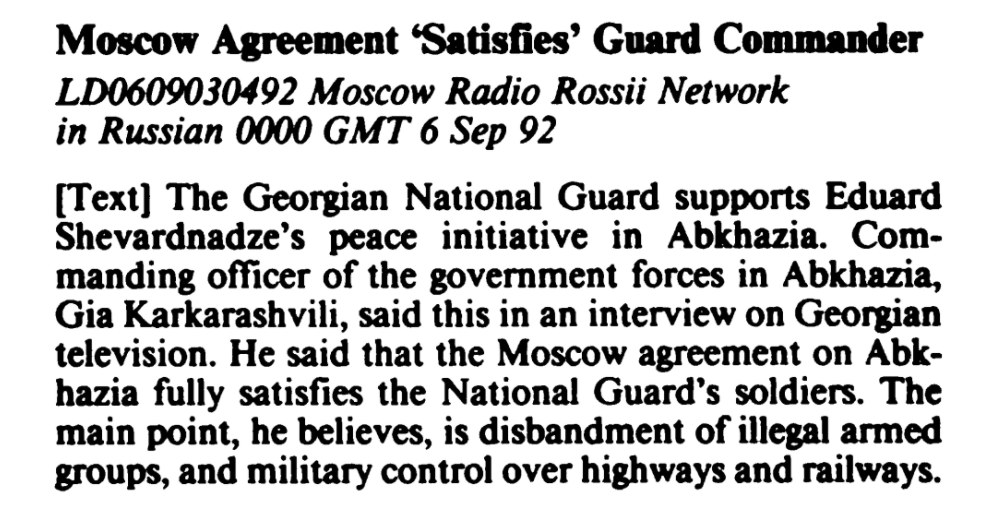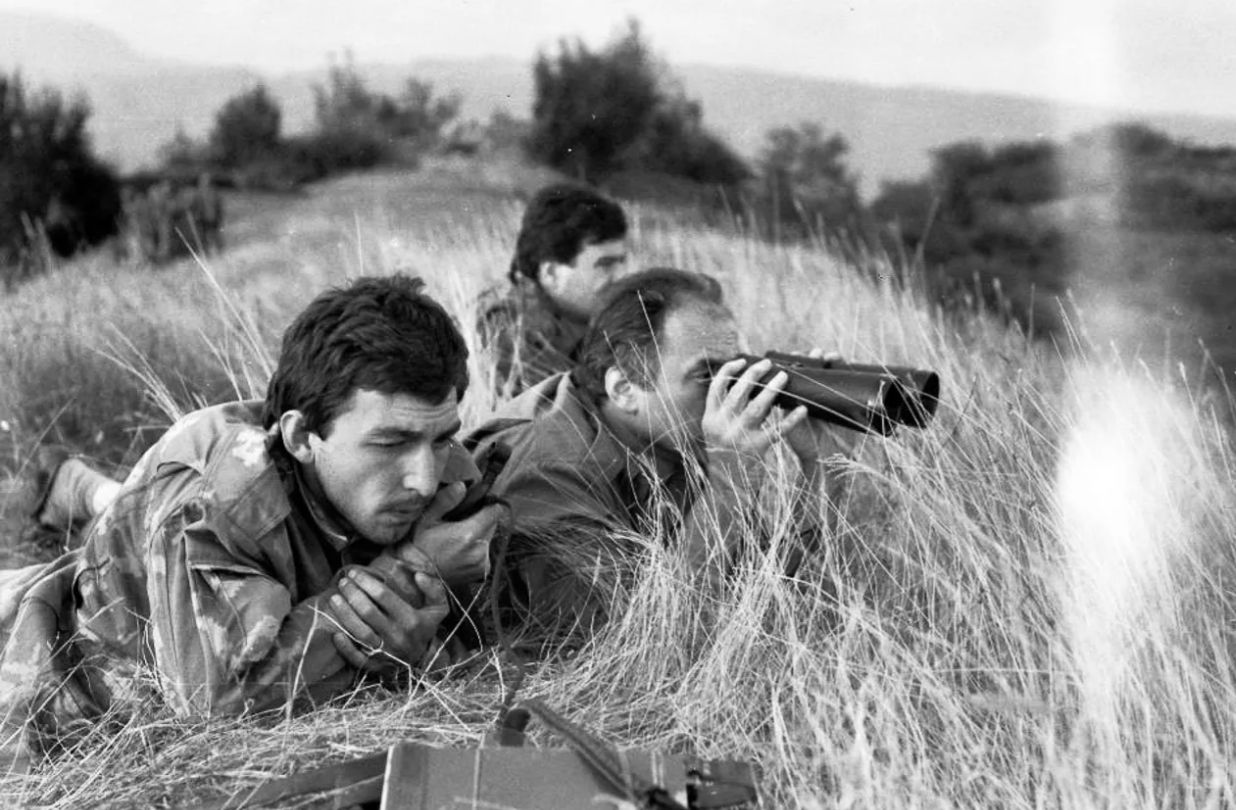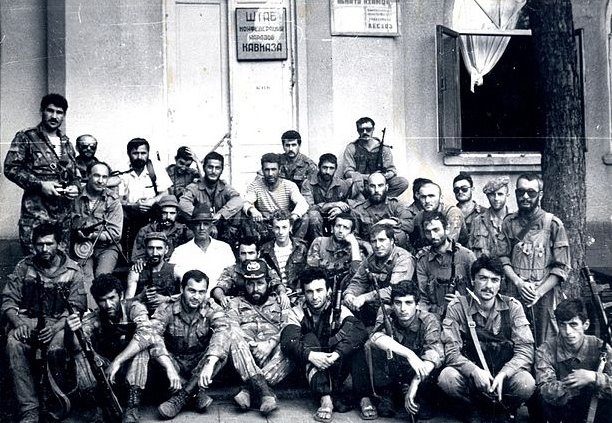Operation "Storm": The Liberation of Gagra District by Abkhazian Troops

By 6 October 1992, Abkhazian forces and volunteers liberated the Gagra District from Georgian control.
The "Storm" operation, aiming to liberate the Gagra District, commenced on October 2, 1992. This victory on the Western front marked the Abkhazian troops' first major military triumph during the war.
Throughout this operation, 117 militia members—comprising locals from Abkhazian districts and volunteers from the North Caucasus—made the ultimate sacrifice. By October 6, 1992, the Abkhazian forces, aided by these volunteers, had freed the Gagra District from the State Council of Georgia's forces. In a symbolic gesture, they hoisted the national flag along the Psou River border.
The Situation on the Western Front
Within a month of the onset of the Patriotic War of the people of Abkhazia, a trilateral agreement was brokered in Moscow on September 3, 1992. This pact, signed by representatives from Abkhazia, Georgia, and Russia, called for a ceasefire.
Contrary to the terms, the Georgian side failed to honour its commitments. With backing from select Russian politicians and continually casting blame on Abkhazia, they sustained their aggression.

During this period, Western Abkhazia found itself under an intense blockade, posing existential threats to its inhabitants. To break free from this stranglehold, offensive measures were imperative. The blueprint for an operation to reclaim the Gagra District was collaboratively designed by Colonel Valeri Arshba, Commander of the Armed Forces of Abkhazia; Colonel Sultan Sosnaliyev, Chief of Staff of the Defense State Committee; and Colonel Sergei Dbar, the acting commander on the Gagra front.
Colonel Dbar promptly undertook efforts to fortify the Gagra defensive line. His strategy prioritised streamlining the front line, arming the troops, ensuring adequate food and clothing, and forging ties with the local community. Levantiy Gitsba assumed the role of deputy commander for personnel, while Captain Arthur Kondzhariya took charge as the deputy commander for logistics. The helm of the Gagra battalion was entrusted to Commander Gennadiy Chanba. Among the bravehearts was Robert Kogonia, a recipient of the Order of Leon, who valiantly fought within the infantry combat vehicle crew.
"Our crew was stationed near the village of Alakhadzy. Rafik Ampar, Shamil Adzinba, Aslan Agumava, and Lavrik Bazba, our gunner, were with us. On October 2nd, our mission was clear: liberate Gagra. That's when our offensive began," recounted the veteran.
Gagra faced attacks from multiple directions. Robert Kogonia's crew took the coastal route. The onslaught was intense, marked by relentless firefights. Yet, even when faced with superior numbers, the Abkhazian fighters pushed ahead with unmatched valour. "The opposition was heavily armed. We had anticipated an even stronger resistance from them. In past skirmishes, our few shots would be met with a barrage in return. Yet, our fighters marched ahead, propelled by their indomitable spirit," he reflected.
Military historian Valiko Pachuliya noted that by September, the Gagra defensive structure had significantly fortified. The front extended from the sea coast at the Alakhadzyh village, cutting across landmarks like the Gagra poultry farm, "Gorgaz", an eucalyptus grove, the railway, the highway, and areas known as "Red Cross", Psakhara, Arasadzyh, and Mamzyschha. The frontline's initial position was by the sea in Alakhadzyh village, guarded by Alik Ajiba's unit. Adjacent to the poultry farm, Nugzar Bagatelia's team held the fort. About 10-15 days prior to the Gagra operation, Ibrahim Yaganov's Kabardinian group fortified the left flank of the poultry farm.
Abkhazian contingents also held pivotal posts, notably around "Gorgaz", within the eucalyptus grove, in villages like Bzyb and Kolkhida, beneath the Mamzyshkha (Мамӡы́шьха) mountain, and along the republican highway.
By mid-September, the Gagra defensive formation was fully operational. A substantial part of this achievement owed to the meticulous planning of the engineering-sapper team led by Rudolf Alshundba.
+ Military Aspects of the War. The Battle for Gagra (The Turning-point), by Dodge Billingsley
+ Georgian-Abkhaz War | FBIS Reports (Aug-Oct. 1992)
+ Levan Mikaa: "The Lost Generation That Fought – It's Not Just an Abkhazian Issue"
The Gagra Offensive
The blueprint for the Gagra offensive was sanctioned by the Chairman of the State Defense Committee, Vladislav Ardzinba. Initially set to commence on the afternoon of September 30, 1992, the operation faced delays due to equipment and personnel readiness issues, prompting Colonel Dbar to temporarily halt the assault.
The operation, aptly codenamed "Storm", initiated at 14:30 with a salvo from multiple artillery. Subsequently, the battalions led by Otar Khetia, Dzhemal Chirikba, Zurik Khvartskia, and Dzhondzhik Tvanba spearheaded the assault on the right flank.
The comprehensive offensive encompassed varied strategic manoeuvres and responsibilities for the Abkhazian military and its volunteer brigades. A pivotal skirmish unfolded near the Kolkhida rural library, occupied by Georgian "guards". During this engagement, Zaver Tvanba of Eshera was tragically lost, while Zurik Khvartskia and Leonid Tsukua sustained injuries.

Distinguished with the Order of Leon, Rafael Ampar, previously engaged at the Gumista front, shared his account: "We reached Bzyb in two BMPs on August 26. From what I recall, our first confrontation spanned almost the entirety of September. The crew of our combat vehicle, comprising roughly thirty individuals, operated in shifts, alternating positions and combat duties." Ampar emphasised the collective sentiment that driving the opposition to the Psou river would pivotally influence the overall war trajectory.
Reinforcements of 30-40 soldiers, led by Zurik Khvartskia and Dzhondzhik Tvanba, were reallocated to the right flank from the Gumista front. By evening, the advancing contingents converged near the junction to the Olgin gorge, securing positions, with a few even stationed themselves above the bypass bridge. Along the central thoroughfare, the Gagra battalion, helmed by Gennady Chanba, pressed on, as detailed by military historian Valiko Pachuliya.
A pivotal assembly of field commanders transpired in Gagra on October 4. The crux of their discussions revolved around the proposition of extending the offensive to reach the Psou river, culminating in the decision to establish two mountain rifle divisions, earmarked for high-altitude deployment.
The Tides of Battle and Breaking the Blockade
As the days progressed, the opposition fortified their ranks. By October 5, the Georgian State Council's forces had introduced additional troops and equipment to the frontline. Notably, the Abkhazian positions near the "Ukraine" sanatorium came under attack. Leveraging tanks and artillery, the enemy initially advanced but soon found themselves repelled by a swift counter-offensive, pushing them back to their starting positions.
Brigades composed of volunteers from the North Caucasus and Kapsh were mobilised. They journeyed by vehicles from the "Tbilisi" sanatorium through Mamzyshkha, eventually reaching the Ashkhabash pass. From this point, they trekked towards the Gazli mountain pasture, traversing a challenging 80-kilometre route. With rugged mountainous landscapes hindering communication, these units endured a gruelling march that lasted over 30 hours.

From dawn on October 5 to the early hours of the 6th, the Kapsh brigade descended towards the Khashupse river, aiming to secure the Tsandripsh bridge. By 5 a.m. on October 6, the North Caucasus volunteer unit reached Cold Creek, while another detachment, named Shakryl, neared the Grebeshok settlement.
Facing intense resistance, the enemy was forced into retreat, leaving behind tanks, weapons, and munitions as they made their way towards Gechripsh. Some took refuge in the surrounding woodlands, while others, discarding whatever arms remained, made a hasty exit from Abkhazia, crossing the Psou river. As the military historian highlighted, "The enemy's retreat was a testament to the determination of the Abkhazian forces."
A significant milestone was achieved on October 6, 1992, at precisely 6:40 a.m. The Republic of Abkhazia's flag proudly unfurled at the Abkhaz-Russian border along the Psou river. This momentous act signified Abkhazia's breakthrough from the blockade and established a crucial connection to Russia. Reflecting on the Gagra front from the Abkhazian perspective, the total casualties stood at 108, with 15 of them being valiant volunteers.